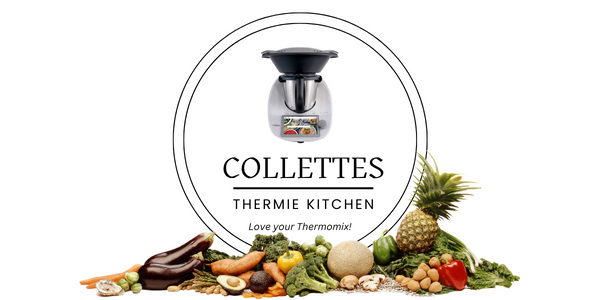Christmas Fruit Cake

This is a simple, rich, moist and memorable Christmas cake that I make for my family each year.
I love to mature it and feed it with Brady and Cointreau as we lead up to Christmas and then marzipan and decorate it in fondant. You can make both the fondant and marzipan in the Thermomix following Cookidoo recipes, but I must confess that I usually buy the pre rolled fondant and block of marzipan. Let’s face it, Christmas week is super busy and I love to spend time with family and friends! If you prefer, a simple Christmas ribbon and blanched almonds on top look wonderful and festive!
This year I made two cakes from my batter!
Start this recipe 8 weeks before Christmas.

Fruit Mix
A typical fruit mix for a Christmas cake often includes a combination of dried fruits, candied fruits. The specific fruits used can vary based on personal preferences and family traditions. You can buy a pre mix of fruit and peel or make a mix of your families favourites like I do. Here’s a list of commonly used fruits for a classic Christmas cake fruit mix:
- Mixed Dried Fruit: This is the base of the fruit mix and can include a combination of raisins, currants, and sultanas. These are the most common dried fruits used in Christmas cake recipes.
- Candied Peel: Candied orange and lemon peel are often included to add a sweet and slightly tangy flavour.
- Cherries: Glacé cherries are a popular addition, both for flavour and the festive red and green colour they bring to the cake.
- Candied Ginger: Candied ginger adds a hint of spiciness and a delightful chewy texture to the cake.
- Dried Apricots: Chopped dried apricots can provide a nice contrast in flavour and colour to the mix.
- Dried Figs: Chopped dried figs can add a rich, earthy sweetness to the fruit mix.
- Dried Dates: Chopped dried dates can contribute a sticky sweetness and additional depth of flavour.
You can adjust the quantities of each fruit based on your preferences. It’s a great idea to soak the dried fruits in alcohol the night before baking the cake. This helps plump up the fruit and infuse it with flavour.
The choice of fruits and their quantities can be tailored to suit your taste. Some people like to experiment with additional ingredients like cranberries or prunes. It’s a great way to make your Christmas cake unique and reflective of your family’s traditions and tastes.

Feeding your Cake
Adding alcohol to a cooked Christmas cake is a traditional way to enhance its flavour and help preserve it. To do this, you can follow these steps:
- Choose your preferred alcohol: Common choices for soaking a Christmas cake include brandy, rum, whiskey, sherry, or even a fruit-based liqueur. The choice of alcohol can significantly impact the flavour of the cake, so select one that you enjoy. My favourite is half Brandy and half Cointreau.
- Pierce holes in the cake: Use a skewer or toothpick to make small holes on the surface of the cake. These holes will allow the alcohol to penetrate the cake, infusing it with flavour.
- Measure the alcohol: Decide how much alcohol you want to use. The amount can vary depending on your preference and the size of the cake. A common guideline is to use 2 tablespoons of alcohol. You can adjust the quantity to your taste. I usually do 2 tbsp a week.
- Slowly drizzle the alcohol: Pour the alcohol slowly and evenly over the surface of the cake. You may want to use a spoon or pastry brush to help distribute it more evenly. Let the alcohol absorb into the cake.
- Wrap the cake: Once you’ve added the alcohol, wrap the cake in plastic wrap or aluminium foil. This will help seal in the moisture and prevent the cake from drying out. You can also wrap the cake in a layer of parchment paper first to protect it further.
- Store the cake: Place the wrapped cake in an airtight container or a cake tin. Store it in a cool, dark place. Some people store it in a cool pantry, while others prefer a refrigerator. The cake can continue to absorb the flavours as it matures over time. I keep mine in a dark corner in my panrty which is cool.
- Periodically feed the cake: To enhance the flavour, you can periodically feed the cake with a little more alcohol. Unwrap the cake, make a few more holes, and add a small amount of alcohol. Re-wrap it and return it to storage. I do this once a week.
It’s common to start this process weeks or even months before Christmas to allow the flavours to develop. The longer the cake is soaked, the richer and more flavourful it will become. Many people start the feeding process a month or two before Christmas for the best results.
Making the Cake
Decorating your cake

Decorating a Christmas fruit cake can be a fun and creative process, and there are various ways to achieve a festive and appealing look. Here are some popular methods
- Marzipan Layer:
- Before decorating, cover the entire cake with a layer of marzipan. This provides a smooth surface and enhances the flavour.
- Use a little of the paste to plug any little holes in your cake.
- Roll out the marzipan to the desired thickness (3-6 mm) and size to cover the cake completely.
- Use a little warmed apricot jam as an adhesive to attach the almond paste to the cake.
- Fondant Icing Layer:
- After applying the almond paste, cover the cake icing. You can make your royal icing or use store-bought ready-to-use icing.
- Smooth the icing over the cake’s surface using a spatula, and you can create various textures and patterns with your spatula or a cake decorating tool.
- Traditional Design:
- A classic and timeless design is to create holly leaves and berries from green and red fondant icing. Do by hand or use a cutter or silicone press/stamp.
- Add a festive message or greeting using icing or edible food markers.
- Consider creating a snow effect with white icing.
- Creative Decorations:
- Use a variety of edible decorations like sugarcraft figures, Christmas-themed toppers, or edible glitter.
- Add small Christmas ornaments or figurines to the top of the cake for a decorative touch.
- Piped Designs:
- Use a piping bag and different nozzles to create intricate patterns, swirls, or floral designs with royal icing. You can also add borders and borders around the base of the cake.
- Edible Paint or Dust:
- Edible metallic paints or dust can add a touch of shimmer to your cake. You can use gold, silver, or other metallic colours to highlight certain areas.
- Ribbon and Bows:
- Tie a festive ribbon around the base of the cake to give it an elegant finish.
- You can also create decorative bows from ribbon or fondant and place them on top of the cake.
- Natural Elements:
- Incorporate natural elements like fresh holly leaves, berries, or pine sprigs for a rustic and traditional look. Ensure these are food-safe and thoroughly washed.
- Personalization:
- Customize the decorations to match your personal style and preferences. You can incorporate your favourite holiday motifs, such as snowflakes, ornaments, or gingerbread men.
- Snow Scene:
- Create a winter wonderland by adding miniature Christmas trees, snowmen, and snowflakes to your cake.
- Traditional Almonds:
- Keep it simple and rustic by adding whole blanched almonds in a circular pattern on top of your cake before baking. Tie a festive ribbon around the cake and enjoy!
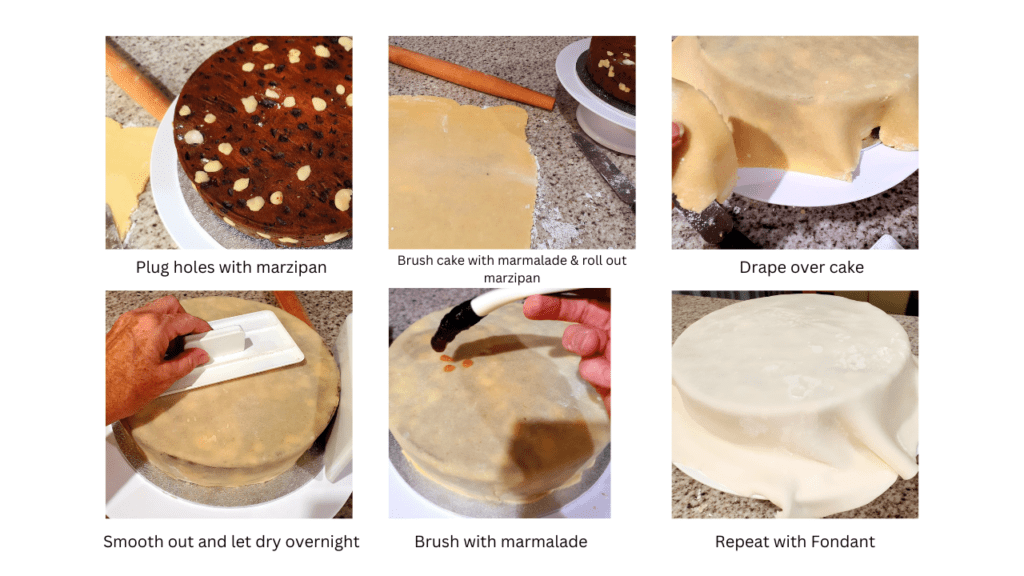
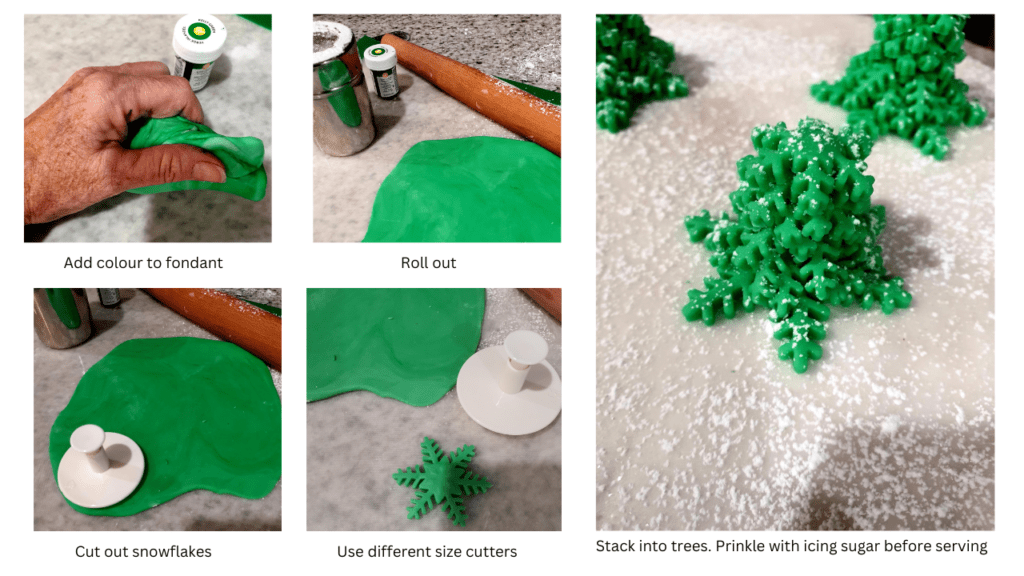
Storing
A well-made Christmas cake can last for a significant amount of time, thanks to its dense and alcohol-soaked nature, which helps preserve it. The shelf life of a Christmas cake depends on how it’s stored and the ingredients used. Here are some general guidelines:
- To store a Christmas cake properly, follow these steps for wrapping and storing:
- Allow the Cake to Cool: Make sure your Christmas cake has cooled completely before storing it.
- Marzipan and Icing: If your cake is covered with marzipan and icing, make sure they have set before wrapping. This might take a day or two.
- Protect the Cake: First, wrap the cake in a layer of baking parchment or greaseproof paper. This helps protect the cake from direct contact with the wrapping materials and helps prevent any transfer of flavours or odours.
- Foil or Plastic Wrap: Next, wrap the cake in a layer of aluminium foil or plastic wrap. Ensure the entire cake is covered, and the wrap is sealed tightly to keep out air and moisture.
- Airtight Container: Place the wrapped cake in an airtight container. This could be a cake tin with a tight-fitting lid, a plastic storage container, or a large airtight bag designed for cakes.
- Store in a Cool, Dark Place: Find a cool, dark spot to store the cake. Avoid storing it in direct sunlight or near heat sources.
- Freezing: If you want to extend the shelf life of your Christmas cake, you can freeze it. Wrap the cake well in plastic wrap and then in foil, and store it in the freezer. A frozen Christmas cake can last for several months to a year or more, depending on ingredients used. When you’re ready to enjoy it, allow it to thaw in the refrigerator, and then bring it to room temperature.
Keep in mind that the specific shelf life can vary depending on the recipe and ingredients used. Always check for any signs of spoilage, such as mould, off smells, or off tastes, before consuming the cake. Proper storage, which includes protecting it from moisture and air, is key to keeping your Christmas cake fresh for an extended period.
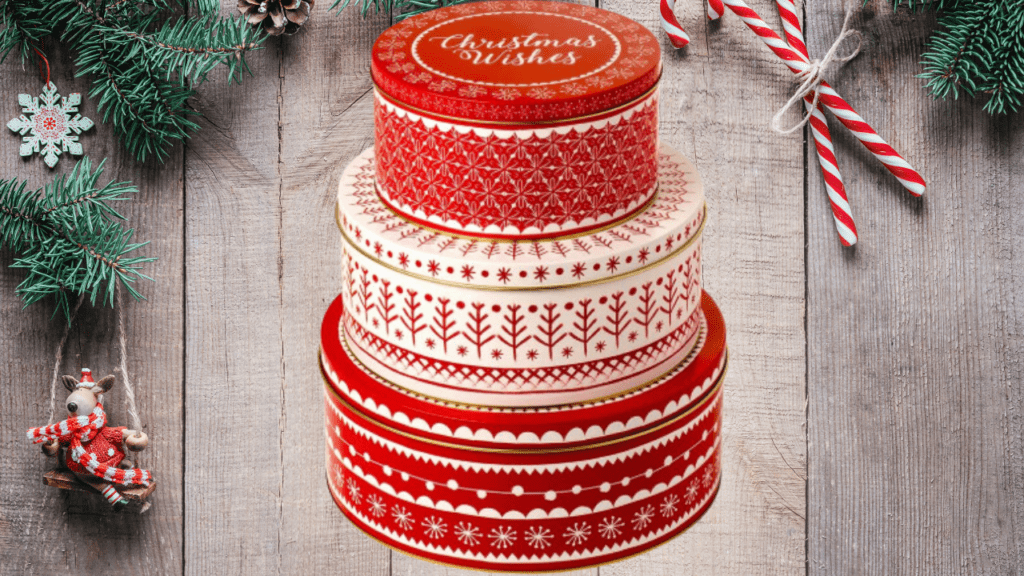
Is my Cake Cooked?
To determine if your is cooked and ready to be removed from the oven, you can follow these general guidelines:
- Check the recommended baking time: This will give you a good estimate of the baking time.
- Use a small knife to test: Insert a small knife in one of the cracks or into the centre of the fruitcake. Hold it there for 5 secs. If it comes out clean or with just a few crumbs clinging to it, the cake is done. If there is wet batter or a lot of crumbs sticking to the toothpick, the cake needs more time.
- Visual cues: The fruitcake should have a golden-brown colour on the top, and the edges should pull away from the sides of the pan slightly. If the cake appears undercooked or has a pale color, it’s not done.
- Press gently: Give the top of the fruitcake a gentle press with your finger. If it springs back and feels firm, it’s likely done. If it leaves an indentation or feels mushy, it needs more time.
- Listen for a hollow sound: Gently tap the top of the fruitcake with your finger. If it makes a hollow, slightly metallic sound, it’s usually a sign that the cake is done. If it sounds dull or wet, it needs more baking.
- Temperature check: You can also use a kitchen thermometer to check the internal temperature of the fruitcake. It’s generally done when the internal temperature reaches around 93-99°C.
Keep in mind that fruitcakes vary in size and composition, and every oven is different, so the exact baking time may differ from one recipe to another. Additionally, it’s essential to avoid overbaking the fruitcake, as it can dry out. If in doubt, you can always use a combination of the methods mentioned above to ensure that your fruitcake is properly cooked.
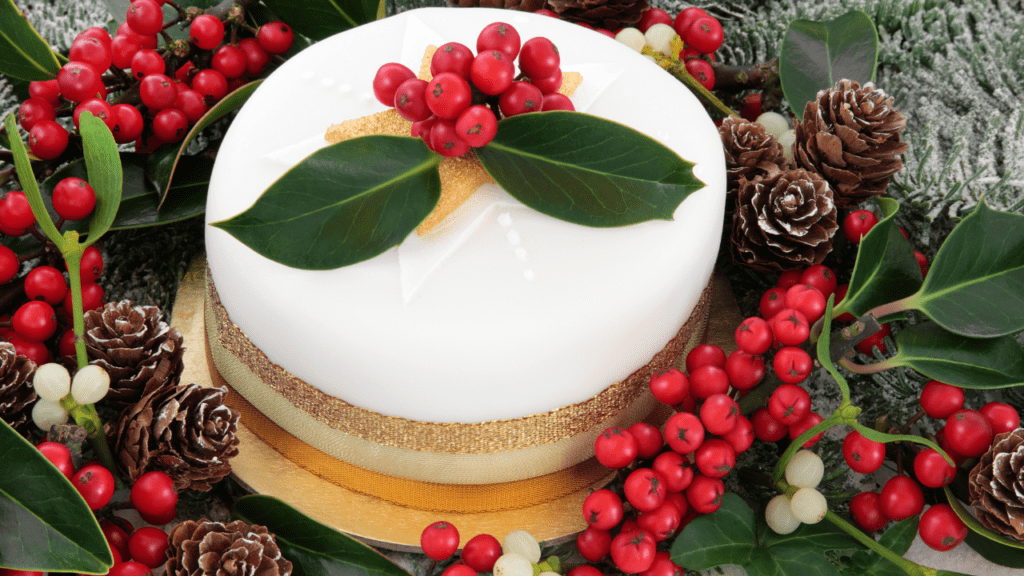
IN SUMMARY – TIPS TO A GREAT CAKE!
Making a great Christmas fruit cake requires some careful preparation and attention to detail. Here are some tips to help you create a delicious and festive Christmas fruit cake:
- Plan Ahead:
- Start early, as fruit cakes often need time to mature and develop their flavours. You can make your fruit cake weeks or even months in advance of Christmas.
- Choose Quality Ingredients:
- Use high-quality, fresh ingredients. The better the ingredients, the better the cake.
- Soak the Fruits:
- Soak the dried fruits (raisins, currants, sultanas, candied peel, etc.) in your preferred alcohol (e.g., brandy, rum, or whiskey) or orange juice for at least a few hours or overnight. This helps plump the fruits and infuse them with flavour.
- The Right Pan:
- Use a deep, round cake tin with a double layer of baking paper lining to prevent sticking and ensure even baking.
- Precise Measurements:
- Follow the recipe and measurements accurately to achieve the right balance of ingredients.
- Proper Mixing:
- Mix the ingredients gently but thoroughly. Overmixing can result in a heavy cake.
- Slow and Low Baking:
- Bake the cake at a low temperature (usually around 150°C ) to ensure it bakes evenly and doesn’t dry out. Place a baking strip or addition baking paper tied with some string around the outside of the tin to prevent the cake from drying and cracking.
- Fruit Distribution:
- Distribute the soaked fruits evenly throughout the batter to ensure a well-balanced cake.
- Marzipan and Icing:
- For a classic Christmas cake, cover it with marzipan) and fondant. Allow the marzipan to set before adding the icing.
- Decorating Creatively:
- Decorate your Christmas cake with festive designs, using icing sugar, marzipan fruits, or edible decorations. Traditional designs like holly leaves, berries, and a Christmas message work well.
- Feeding and Maturing:
- As mentioned in the previous answer, consider feeding the cake with alcohol regularly to keep it moist and enhance the flavour. Wrap the cake well to maintain its moisture, and store it in a cool, dark place to mature.
- Personalize:
- Add your own touch to the recipe by including ingredients like chopped nuts, spices, or citrus zest to suit your taste.
- Taste Testing:
- Taste and adjust as you go. Taste your batter. After maturing, taste a small piece of the cake to ensure the flavour is to your liking. If necessary, you can feed it a final time to adjust the taste.
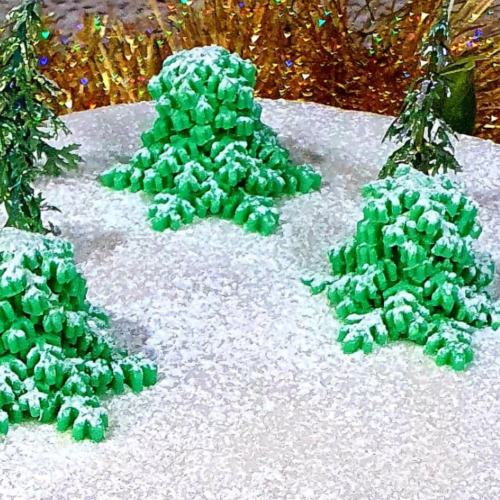
Christmas Fruit Cake
Equipment
- 1 TM5 or TM6
- 1 20cm cake tin
- Baking paper
- String
Ingredients
- 1 kg dried mixed fruit see notes in post
- 250 grams alcohol or orange juice I love half brandy, half cointreau
- 1 green apple quartered
- 1 squeeze lemon
- 250 grams butter cubed
- 250 grams brown sugar dark or light
- 1-2 tbsp Christmas spice Mix See notes below
- 1 orange zest only
- 1 tsp salt flaked sea salt
- 150 grams Plain Flour
- 150 grams Self Raising Flour
- 1 tsp bi-carb soda
- 2 tbsp cocoa powder
- 4 eggs large
- 3 tbsp orange marmalade
- 100 grams mixed nuts
Decorating
- 120 grams whole blanched Almonds If not icing
- Festive ribbon to fit around your cake.
Instructions
Soaking the Fruit
- Add 1 kg mixed dried fruit and 250g of your chosen alcohol or orange juice to Thermomix Bowl and warm 4 mins/100℃/Reverse/Speed 1/ no measuring cup, but simmering basket sitting on lid. Once the mix reaches 100℃ remove from heat and let sit, covered in a bowl overnight. The fruit will absorb the alcohol and plump up.
Mixing the Cake
- Add 1 green apple, cored and quartered to the Thermomix with a squeeze of lemon and turbo a couple of time to chop into small pieces. Set aside.
- Add 250 grams of cubed butter to the Thermomix and melt: 4 mins/60℃/speed 2.
- To the melted butter, add:250 brown sugar1-2 Tbsp Christmas Spice Mix (see below)1 tsp saltzest of one orangePre-grated apple that we set aside earlier.Soaked mixed fruit.Mix well with your spatula and cook 5 mins/80℃/Reverse/Speed 1
- Tip cake contents into a large bowl to cool. Clean Thermomix Bowl.
- Add 150g plain flour, 150g self raising flour and 2 tbsp cocoa and 1 tsp bi-carb soda to a clean Thermomix bowl. Sieve on Turbo for 3 times, 1 second pulses. Add 4 eggs and 3 tbsp marmalade and mix 10 seconds/speed 5.
- Add the cake mix to the cooled fruit mix along with the mixed nuts and combine by hand with the Spatula. It will be thick to begin with but will come together. You can add a little more brandy or orange juice if needed.
- BAKING
- Pre – heat oven 140℃ Fan or 160℃ conventional.
- Line a 20 cm cake tin with a double layer of baking paper, making sure it has at lease a 6cm collar that rises above the top of the tin. Line the base of the tin with a circle of baking paper. Line the outside of the tin and ties with string.
- Spoon cake mixture into tin and level the top with a wet angled spatula or a damp hand. If not icing, place your whole blanched almonds decoratively on top,
- Cook in the middle of the oven for 3 – 3¼ hours. If the cake starts to brown too much on top, you can cover it with foil.Allow the cake to cool in the pan for about 20 minutes, then transfer it to a wire rack to cool completely.Brush with some extra brandy and wrap it l and store it in an airtight container. Feed the cake each week (see notes in post).
